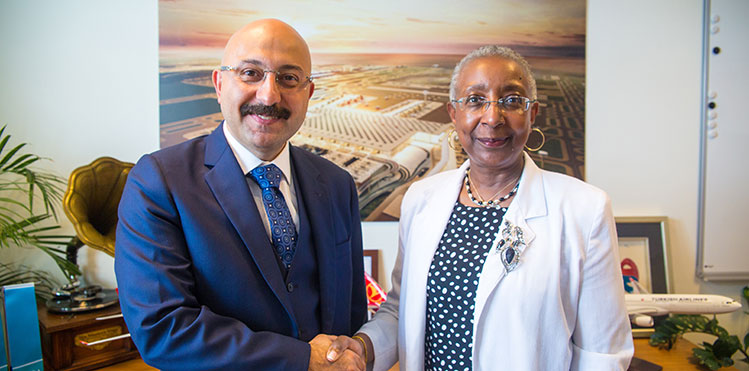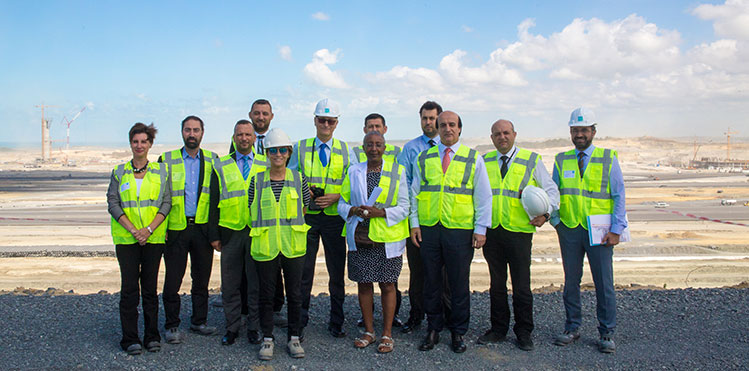In July, ACI World Director General Angela Gittens and Director Safety and Technical David Gamper met with Hüseyin Keskin, CEO of İGA Airport Operation. They also took the opportunity to visit the Istanbul New Airport site. Keskin and Gittens shared their thoughts with Ross Falconer.

Hüseyin Keskin, CEO of İGA Airport Operation, and Angela Gittens, Director General of ACI World.
Hüseyin Keskin, CEO İGA Airport Operation
With economic growth of +5% (GDP) in Q2 2017, Turkey’s airports have also shown some strong recovery (+8% in April). After the difficulties of 2016, is 2017 the year of the re-bound for Turkish tourism and travel?
Hüseyin Keskin: Tourism is one of the national economy’s leading sectors, both for employment and contributing to capital investment. The World Bank has raised Turkey’s economic growth projections for the next three years. According to its Global Economic Prospects report, Turkey’s economy is now expected to expand 3.5% in 2017, up from an estimated 3% in January. It’s an enormous achievement that – despite the many challenges we were facing after the failed coup attempt – economic growth could recover and even get stronger. After a decline due to the security concerns last year, the number of foreign tourists visiting Turkey in May increased by 16.27% compared to the same month last year. The number of foreign visitors from January to May this year increased by 5.5% year-on-year. So, we’re looking towards a bright future for the Turkish tourism and travel industry.
Construction of İstanbul New Airport is 55% complete – what work remains to be done?
Keskin: Completion of more than a half of the construction is a significant milestone. The main terminal with a capacity of 90 million passengers, three runways, and support facilities, will be ready for the end of the first phase of construction and the opening in 2018. Construction of the air traffic control tower is completed already. The earthworks for the first runway, which is 3,750m long and 60m wide, along with all taxiways have been completed to a great extent. Despite the challenging winter conditions in 2016/17, we as İGA aim to finalise the first phase of investment in 2018 and start airport operations in 2018.
İstanbul New Airport has natural geographic advantages – do you still expect it to “become the biggest hub in Europe by the early 2020s”?
Keskin: There is no reason to doubt that İstanbul New Airport (INA) will be the biggest hub in Europe by the early 2020s. Due to its unbeatable geographic position as a natural bridge, INA will be established as one of the world’s leading airports and will offer an excellent connection between East and West. From Istanbul, it is possible to reach many destinations in four hours due to the country’s geographic location. The rising importance of Atatürk Airport – which doubled its passenger numbers in the last five years – shows the importance of Istanbul as a European hub.
What new connectivity opportunities will İstanbul New Airport provide? And in what ways will it be “a breath of fresh air to Turkish competitiveness across the world”?
Keskin: As a hub, INA will provide an extensive flight network, considerable cost advantages, and will contribute to competitive superiority. The “breath of fresh air to Turkish competitiveness” can be seen in the success of Turkish Airlines, which could – by implementing Atatürk as its main hub – increase its passenger numbers from 14 million in 2005 to 62 million in 2016. The connectivity of Istanbul is high – Istanbul, as a transfer point on global routes, reduces flight time and introduces the flexibility to use a variety of aircraft of diverse capacity. Around 100 airlines will offer their services at INA. In July 2017, İGA signed and announced several important agreements with six of Turkey’s largest companies which are active in the areas of cargo and ground services.
İstanbul New Airport plans to build a “new aerial Silk Road, connecting East and West”. Will the opening mean that THY will also announce new routes – perhaps the first routes to Australia for instance?
Keskin: There aren’t many airlines flying to Istanbul Atatürk Airport from the Americas, China, India, Africa, and Southeast Asia. Thanks to the bridges that İGA will build with new regions, the commercial power of Turkey will receive a boost and economic development will be accelerated. The airport will enable the connection of countries like India and China to Europe via Istanbul, which was not possible before, establishing a kind of aerial Silk Road. INA’s unbeatable geographic position and its enormous capacity may inspire some airlines to broaden their set of routes – also THY!
It has been reported that İstanbul New Airport will make a 4.9% contribution to Turkey’s GNP. In what ways will it “radically change Turkey’s position in the global economy”?
Keskin: According to IATA, the aviation industry will grow twice as fast as the world’s economic growth in the upcoming 35 to 40 years. Turkey has to build INA to set new standards and meet this future demand. INA will make a 4.9% contribution to the national income per capita. Also, the airport will provide employment to as many as 225,000 people and make a $40 billion contribution to Turkey’s economy by 2025. So, INA is a megaproject and a strategic investment. It is not just planned for today, but for the future. By the early 2020s it will become the biggest hub in Europe and will be the driving force behind Turkey’s growth.

ACI World Director General Angela Gittens and Director Safety and Technical David Gamper met with Hüseyin Keskin, CEO of İGA Airport Operation and his team in July. The visit included a tour of the Istanbul New Airport site.
Angela Gittens, Director General, ACI World
What changes do you think İstanbul New Airport will bring to the aviation industry?
Angela Gittens: The development of this impressive programme to provide sufficient infrastructure to accommodate the future demand and realise the vision of the country and its capital city, may invigorate other governments to face up to the challenge and opportunity of bringing their infrastructure in line with the ambitions and needs of their people and their economy.
What are the mutual gains from the visit?
Gittens: For ACI, it was a reassurance that the developer/operator was on the right track for this, one of the most important airport projects in the world. For İGA, I hope we were able to be helpful in offering suggestions, lessons learned and sources of additional guidance.
What suggestions have you provided to İGA today?
Gittens: We suggested that their ORAT team reach out to other airports to peer review their plans. İGA has been very proactive in seeking lessons learned and critical reviews of their design and development plans, and they should exercise that same approach on the ORAT. They have a huge challenge in that they plan to transfer overnight from Atatürk, so there are a multitude of processes that have to go right, not the least of which is the selection, training and familiarisation of staff that are coming from Atatürk. Because of the transfer approach, we suggested that they get the airlines, particularly Turkish, to reduce schedules for a period of time. Obviously, this is not a pleasant ask, but the airlines, the airport and the passengers will be better off if they don’t have to operate at maximum from day one.
What ACI initiatives would you propose to İGA that you believe will be beneficial?
Gittens: İGA has already taken advantage of some of ACI’s training courses and we have suggested that they hold one in Airport Excellence in Safety, and one in Security in their early stages. As well, it would be useful for them to enter ASQ early on, so they can make the right adjustments to accommodate the priorities of their specific customer base as they work into the new facility. We also suggested that they consider establishing themselves as an ACI Training Facility like we had at Atatürk (TAV Academy) so they can continue the training process for themselves, as well as for other airports. They have to accept the fact that they will be a leader.
What would be ACI’s direct or indirect support to the ORAT process? What would be the gains for ACI from the ORAT process?
Gittens: İGA has selected two excellent airports, Incheon and Copenhagen, as their ORAT consultants. We are happy to work with them in getting insights from our Safety and Technical and Facilitation and Services Standing Committees, or helping them arrange peer reviews. As well, we can offer customised training and can ramp up extra training for them as we did with Airports Company of South Africa ahead of their accommodation of the World Cup.
What are your thoughts on the construction itself?
Gittens: The construction challenges have been tremendous; the site is brownfield not greenfield and is far from flat, so the earthwork has been a major engineering and construction feat that is still underway. The design has had to work around structural weakness in the site due to its former use for coal mining. We were quite impressed with the approach they have taken and the amount of talent they have amassed to successfully design and execute solutions.
Do you see any challenges ahead for İGA?
Gittens: They have already faced and managed many challenges, are in the midst of others, and have before them three main ones:
- Terminal finishes and systems usually take longer than anticipated and changes by users can be a nightmare. Often, relatively low-volume users, like the non-dominant carriers aren’t able to pay close attention to detail until the finishing work starts. We suggested using the sophisticated simulation tools they have developed to try to engage all users in understanding what their operation is going to be like before they install, so İGA can deal with changes before reaching a critical point. Any time one makes changes in a live environment it affects life/safety systems which have a go/no-go impact.
- Transition and familiarisation of staff as mentioned above. There are few shortcuts to this, yet there are limits to what can be done far in advance, so organisational agility and a ‘Plan B’ attitude will be important. This can be extremely expensive.
- The road and rail connections to the airport are not under İGA’s control, so the timing may or may not correspond to the airport’s opening.







